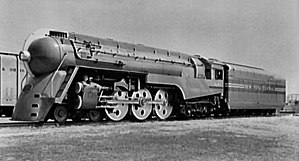Henry Dreyfuss ContentsCareerLater lifeDeathReferences and Further ReadingNavigation menucurrent revisionT87
1904 births1972 deathsPeople from BrooklynDesigners who committed suicideAmerican industrial designersPeople from New York CitySuicides by carbon monoxide poisoningSuicides in California
industrial designerBrooklynNew YorkRaymond Loewyergonomicsanthropometricshuman factorsNorman Bel GeddesautobiographySouth Pasadena, Californiaterminally illsuicidecarbon monoxideliver cancerISBN 0471288721ISBN 1581153120ISBN 0-8478-2010-6ISBN 0300108044
Henry Dreyfuss
| This is an old revision of this page, as edited by MrOllie(talk | contribs) at 15:46, 23 March 2010 (Reverted 1 edit by Hammack; Rv, COI. (TW)). The present address (URL) is a permanent link to this revision, which may differ significantly from the current revision. |
Jump to navigation
Jump to search

One of the Hudsons given a streamlined casing of Henry Dreyfuss' design to haul the 20th Century Limited.
Henry Dreyfuss (March 2, 1904 – October 5, 1972) was an American industrial designer.
Contents
1 Career
1.1 Designs
2 Later life
3 Death
4 References and Further Reading
Career
Dreyfuss was a native of Brooklyn, New York. As one of the celebrity industrial designers of the 1930s and 1940s, Dreyfuss dramatically improved the look, feel, and usability of dozens of consumer products. As opposed to Raymond Loewy and other contemporaries, Dreyfuss was not a stylist: he applied common sense and a scientific approach to design problems. His work both popularized the field for public consumption, and made significant contributions to the underlying fields of ergonomics, anthropometrics, and human factors.
Until 1920 Dreyfuss studied as an apprentice to theatrical designer Norman Bel Geddes, his later competitor, and opened his own office in 1929 for theatrical and industrial design activities. It was an immediate and long-lasting commercial success. As of 2005 his firm continues to operate as Henry Dreyfuss Associates with major corporate clients.
Designs
Significant original Dreyfuss designs include:
- the "Western Electric 302" tabletop telephone for Bell Laboratories (1930, produced 1937-1950)
- the Hoover "Model 150" vacuum cleaner (1936)
- the classic Westclox "Big Ben" alarm clock (1939)[1]
- the New York Central Railroad's streamlined Mercury train, both locomotive and passenger cars (1936).
- the locomotive of the NYC's"Twentieth Century Limited" (1938)
- the popular "Democracity" model city of the future at the 1939 New York World's Fair
- the styled John Deere Model A and Model B tractors (1938)
- the Wahl-Eversharp Skyline fountain pen (1940).
- the "500" desk telephone (1949), a Bell System standard for years
- the Honeywell T87 circular wall thermostat (1953).
- the spherical "Model 82 Constellation" vacuum cleaner for Hoover (1954) which floated on an air cushion of its own exhaust.
- the "Princess" telephone (1959)
- the "Trimline" desk telephone (1965).
Later life
In 1955 Dreyfuss wrote Designing for People, an autobiography which features his "Joe" and "Josephine" simplified anthropometric charts. In 1960 he published The Measure of Man, an ergonomic reference.
Dreyfuss was the first President of the Industrial Design Society of America (IDSA).
Death
On October 5, 1972, at their home in South Pasadena, California, Dreyfuss and his wife, Doris Marks, who was terminally ill, committed suicide. They were found in a car, killed by self-inflicted carbon monoxide poisoning. Earlier that year, Marks had been diagnosed with liver cancer. The design company, Henry Dreyfuss Associates, remains after his death.
References and Further Reading
Dreyfuss, Henry. Symbol Sourcebook: An Authoritative Guide to International Graphic Symbols. New York: John Wiley & Sons. 1984. ISBN 0471288721
Dreyfuss, Henry. Designing for People. Allworth Press; illustrated edition edition, 2003. ISBN 1581153120
Flinchum, Russell. Henry Dreyfuss, Industrial Designer: The Man in the Brown Suit. Rizzoli, 1997. ISBN 0-8478-2010-6
Innes, Christopher. Designing Modern America: Broadway to Main Street. Yale University Press, 2005. ISBN 0300108044
Categories:
- 1904 births
- 1972 deaths
- People from Brooklyn
- Designers who committed suicide
- American industrial designers
- People from New York City
- Suicides by carbon monoxide poisoning
- Suicides in California
(window.RLQ=window.RLQ||[]).push(function()mw.config.set("wgPageParseReport":"limitreport":"cputime":"0.020","walltime":"0.025","ppvisitednodes":"value":46,"limit":1000000,"ppgeneratednodes":"value":0,"limit":1500000,"postexpandincludesize":"value":0,"limit":2097152,"templateargumentsize":"value":0,"limit":2097152,"expansiondepth":"value":2,"limit":40,"expensivefunctioncount":"value":0,"limit":500,"unstrip-depth":"value":0,"limit":20,"unstrip-size":"value":0,"limit":5000000,"entityaccesscount":"value":0,"limit":400,"timingprofile":["100.00% 0.000 1 -total"],"cachereport":"origin":"mw1270","timestamp":"20190422004547","ttl":2592000,"transientcontent":false);mw.config.set("wgBackendResponseTime":235,"wgHostname":"mw1270"););